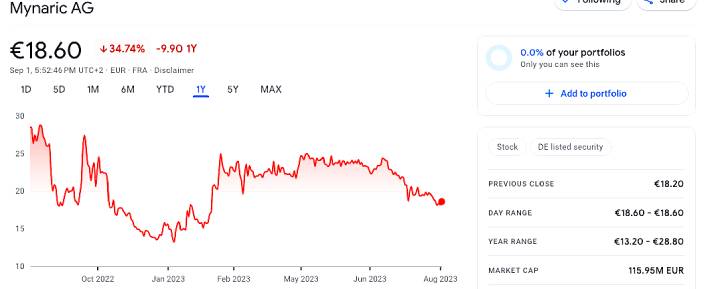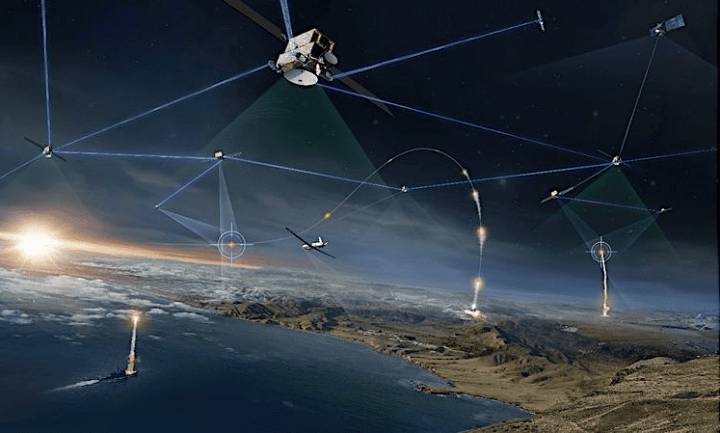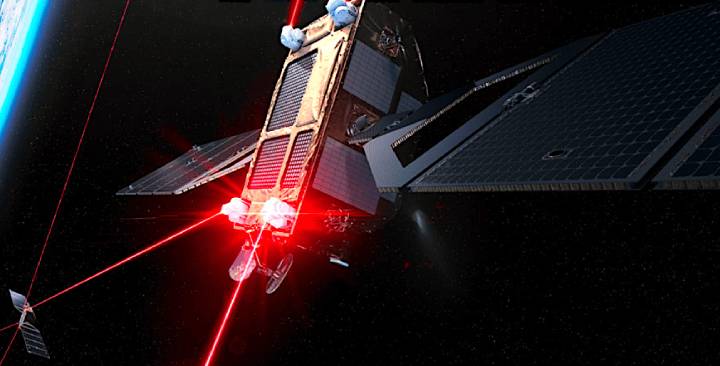 (Source: Google Finance)
(Source: Google Finance)
LA PLATA, Maryland — Space and airborne laser communications terminal (LCT) builder Mynaric AG reported a backlog of 348 units as of April 27, up from the backlog of 256 terminals as of Dec. 31.
Some of the new orders were accompanied by cash advances from customers. The company had reported 18.3 million euros ($19.5 million) in customer advances as of Dec. 31, 2022, and said it booked another 18.8 million euros in advances in the first four months of 2023.
Germany-based Mynaric is one of several companies under contract to the U.S. Space Development Agency (SDA) and the U.S. Defense Advanced Research Projects Agency (DARPA) to test lasers on relatively small satellites in low Earth orbit. The company in October 2021 concluded a strategic agreement with Northrop Grumman that gives Northrop exclusive access to Mynaric LCTs in contracts where the U.S. government was the end customer.
 The US Space Development Agency has selected Northrop Grumman to build 42 Tranche 1 Transport Layer and 14 Tracking Layer satellites. (Source: Northrop Grumman)
The US Space Development Agency has selected Northrop Grumman to build 42 Tranche 1 Transport Layer and 14 Tracking Layer satellites. (Source: Northrop Grumman)
Northrop Grumman is building 42 satellites as part of SDA’s Tranche 1 Transport Layer constellation. Mynaric and Northrop in March 2022 concluded a contract, valued at $36 million, under which Mynaric’s LCTs would be used for this work. Northrop will be making milestone payments through 2024, with deliveries to Northrop in 2023 and 2024.
The goal of both the SDA and DARPA is to field LCTs that not only transfer large quantities of data between satellites at high speed, and eventually to the ground, but also that can function when competitors’ LCTs are at one or the other end of the transmission.
Mynaric is investing heavily, ahead of customer orders, in plant and equipment to be able to produce 2,000 lasers a year — a key performance indicator for future commercial and government satellite constellations.
The cost of ramping up its work force and its production capacity ahead of revenue is a delicate one, especially since the competitive landscape for space borne lasers has become more challenging.
Mynaric competes with Tesat Spacecom, a unit of Airbus Defence and Space and the company with perhaps the longest experience with lasers for inter-satellite communications links; CACI international’s SA Photonics; General Atomics; Honeywell International; Skyloom Global and Space Micro, among others.
The largest commercial broadband constellation, SpaceX’s Starlink, is adding SpaceX-designed LCTs but has shown no inclination to become a merchant supplier to others.
Spire Global is debuting in-house-designed LCTs on its constellations but has said it’s not interested in selling the technology to third parties.
Three commercial satellite broadband constellations are in the market now, or soon will be, to outfit their future networks. All have commercial or regulatory time constraints.
— The OneWeb constellation is all but certain to employ LCTs for its second generation of 600-plus satellites.
— Rivada Space Networks has said the 300 satellites being built by Terran Orbital will all be fitted with LCTs.
— Telesat of Canada’s Lightspeed broadband constellation of 198 satellites, now reborn with MDA Ltd. as prime contractor, likewise plans LCTs.
 (Source: Mynaric)
(Source: Mynaric)
Mynaric reported an operating loss of 73.8 million euros on revenue of 4.42 million euros in 2022.
In an Aug. 23 filing with the U.S. Securities and Exchange Commission (SEC), said that as of April 27 it had 51.8 million in cash as of Dec. 31, 2022.
$75 million loan agreement with liquidity requirements
Mynaric’s U.S. subsidiary, Mynaric USA, which is managing the SDA and DARPA business, closed a secured loan agreement with a U.S.-based investment management company for $75 million. Mynaric immediately drew the full amount of the facility.
As part of the agreement, certain lender affiliates agreed to purchase new Mynaric shares equivalent to 9.1% of the company’s equity. The transaction is still pending.
The credit agreement includes covenants that set limits to Mynaric’s debt level and require average weekly liquidity of $10 million, starting with the quarter ending last June 30.
Impairment charge on MEO product line with SpaceLink default
Mynaric had been under contract to provide 30 LCTs to SpaceLink, which planned a constellation of data-relay satellites in medium-Earth (MEO) orbit. SpaceLink ceased operations in 2022 and defaulted on payments to Mynaric, which booked an impairment charge of 1.5 million euros on its MEO product line.
A 150,000-euro fine for violating financial-disclosure rules
Mynaric, whose equity s traded on the Frankfurt Stock Exchange and on the U.S. Nasdaq exchange, in early 2020 told investors it had won a multimillion-euro LCT contract with an unnamed customer that was later disclosed as being Chinese.
The company apparently believed that German government would have no problem with the deal because LCTs were not classed as a dual-use item.
In July 2020 German regulators banned the shipment of LCTs to China. Also in 2020, Germany’s Federal Financial Supervisory Authority, BaFin, ruled that Mynaric had violated financial disclosure rules about the Chinese contract. In March of this year, BaFin imposed a fine of 150,000 euros.
Read more from Space Intel Report.
